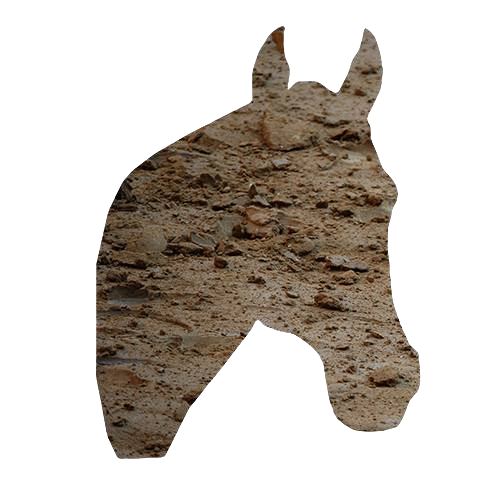www.thepalio.eu - dal Belgio con amore
Siena : History and art
History and art
Many visitors of our website show that their interest in Siena goes beyond the Palio. Rightly so. Siena is without a doubt the most beautiful later city in the world. A preliminary glance at any book on general art history makes it clear that European art history from the period 1250 to 1340 is to a great extent the art history of Siena. Sienese creations of architecture, sculpture and painting are among the most important illustrations of the period.
Siena is located on three hills, with surprising perspectives, winding and ascending streets and alleys, churches and palaces whose interiors beg to be visited, an art heritage of the highest quality and where everything finally comes together in the magical Piazza del Campo , the place of the Palio.
The Palio-Experience
It may not be the race that does it, but the unparalleled backdrop that seems to be made for this event and actually isn’t, and around it in the center the contrade with their midieval headquarters and often half-hidden stables in the most surprising places.
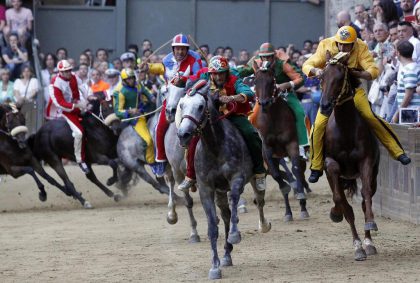
It is actually incomprehensible that the front courtyard of the birthplace of Saint Catherine, patroness of Europe, and converted into a beautiful place of pilgrimage, functions as the place where Oca’s horse is washed and walked after every practice ride. And what should we think of the many beautiful medieval sources that serve as a backdrop for the festivals of contrade, such as the Fontebranda of Oca and the Fonte Nuova of Lupa. Bruco celebrates in a garden, laid out in a sloping landscape next to the suggestive medieval city walls.
Drago is hidden in the medieval cloister garden of the imposing San Domenico en Selva in the breathtaking little square in front of the Baptistry under the choir of the cathedral. And what about some contrade headquarters such as the 12th century courtyard of Civetta in the Vicolo del Castellare where their stable is also located, or, completely different, the nicely modernized interior of the headquarters of Istrice.
Or the stables of Giraffa next to and under the baroque church of Provenzano and the stables of Selva in the Vicolo delle Carrozze. Or what about Aquila in the small Via dei Percennesi where you can experience a medieval experience rarely found in Europe.
And who makes a stable in a deconsecrated baroque chapel, unless it is Chiocciola in the Cappella della Madonna del Rosario. And where in the world are open-air parties organized in winding, up and down streets such as in Torre and in Onda . And who celebrates on a small square bordered on one side by a baroque church and on the other side by the oldest surviving bank building in the world, such as Civetta or Giraffa on the square in front of the High Renaissance church of Provenzano, which unfolds beautifully after a long descending street. Aquila celebrates his victories within the grandiose setting of the unfinished nave of the Duomo.
In short, the integration into the urban setting of contrade and the use of medieval streets, squares, palaces, churches and chapels is an essential part of the Palio Experience and an example of a total but high-level aesthetic alienation.
Here follows a history of Siena with a great deal of attention to its cultural and artistic achievements, and separately a concise tourist guide for those who want to see a little more of this city. Finally, there is also a culinary guide, with tips for restaurants and bars, culinary considerations and an introduction to the wines of the Province of Siena.
LOCATION – DEMOGRAPHY – CLIMATE – ISOLATION – LANDSCAPES
Siena is located on three hills and is a stone city with only greenery in the center on the edge of the old city walls, in the center of Tuscany, about 70 km. south of Florence. It is the capital of a province of the same name in the greater Tuscany region. At the last census of 2011, Siena had a population of 52,839, to which approximately 6,000 temporary residents may be added, mainly students and a group of executives from the local bank. This is a marked decline from the 1971 census when the city still had 65,634 inhabitants. The explanation for this is the extraordinary increase in the price of real estate due to the expansion of the bank and university, not only in terms of temporary residents, but also because of the large and expensive spaces occupied by these institutions in the center of the city. In addition, Siena has developed a larger and more expensive shopping center, especially compared to the very provincial character of the city well into the 1980s.
The climate is pleasant to the south, not too cold in winter, usually very hot in summer but sometimes with a strong refreshing wind, very pleasant in autumn except for the classic rain showers that peak between the end of October and the beginning of December.
When the construction of the Autostrada del Sole started in 1964, they did not go from Florence via Siena to Rome, as the medieval Via Francigena did, but instead opted for a large curve via Arezzo. It contributed to a certain isolation in the 20th century. People in Siena are still complaining about the inadequate, i.e. too narrow and poor-quality connections with Florence, with the Autostrada del Sole and the south of the province. It has been worked on for several years. On the other hand, its isolation may have saved Siena from many of the “blessings” of modern times.
Finally, the town is surrounded by beautiful and varied landscapes : the delightful Chianti hills to the north towards Castellina in Chianti and to the east towards Castelnuovo Berardenga and Gaiole in Chianti, the melancholy Montagnola to the west and the unique Crete in South.
It is no coincidence that after only a limited number of editions, the “Strade Bianche” at the beginning of March has become a new phenomenon in cycling, with commentators almost demanding that the race be recognized as a new “classic”. After a journey through a formidable competitive terrain in Le Crete, often on paved white dirt roads hence “Strade Bianche” and with steep hills, and a deadly final climb via Fontebranda to the centre, the race arrives at the Piazza del Campo. Italian friends assured me that since the 2016 edition, people in the hotels, restaurants and streets of Siena have the impression to hear more Flemish than Italian
And that for a course of which our webmaster in 2008, as a privileged witness of the second edition, found that there were hardly any people on the Piazza. The race was then called the Monte Paschi Eroica and won by Fabian Cancellara. The Strade Bianche originated from an amateur race called L’Eroica starting in Gaiole in Chianti, held in the first week of October. L’Eroica is a competition for amateurs on bicycles from before 1997 (hence the heroic) over 209.1 km, through the most beautiful countryside of Italy in five parts : the southern Chianti, the Val’ d Arbia near Siena, Le Crete which Siena, the Val d’Orcia around Pienza and finally Montalcino.
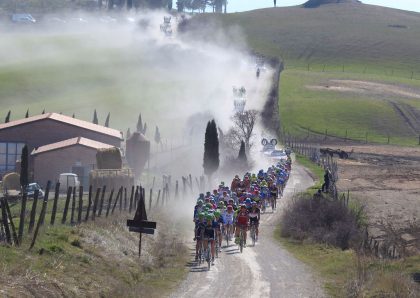
Mi raccomando : don’t look around too much at this breathtaking landscape in every season, but always look at the road and steer.
Real amateurs can ride the course all year round. There are no less than 90 direction indicators and 80 signs with kilometer indications along the road “L’Eroica – Percorso Cicloturistico”.
You will find information at the tourist office of Siena on the Piazza del Campo and that of Terre di Siena on the Piazza del Duomo, as well as on the internet sites of L’Eroica and Terredisiena.
History
PART I – ETRUSQUES AND ROMANS
Archaeological finds show that Siena was an Etruscan foundation named Saina or Seina. The legend about the origin of the city, of course, tells a different story. Romulus, co-founder of Rome, sent two captains to Siena to deal with Ascanius and Senius (hence Siena), sons of his brother Remus, whom he had already killed in the struggle for kingship. Consequently, the Roman she-wolf appears in the flag and on many memorial stones in Siena as a daughter city of Rome. However, it is certain that Emperor Augustus founded a small Roman military colony there, known as Saena Iulia.
PART II – The MIDDLE AGES
From the Fall of the Roman Empire over the Dark Ages to a European Capital
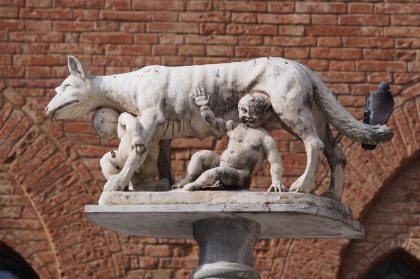
After the fall of the Roman Empire, a dark period followed in which Siena was conquered first by the Lombards and then by the Franks of Charlemagne, who ruled through an imperial count. In the 10th century, a modest revival of trade and, not to be underestimated, of pilgrimages to Rome began in Italy. Siena was right on the famous Via Francigena pilgrimage route that ran from Canterbury in England across France and Switzerland via the Tuscan coast and inland to Rome.
In the course of the 12th century, Florence and Siena in Tuscany took over from Pisa and Lucca as the main trading cities. Siena became more than an independent city, it became a city-state, a republic led by aristocratic consoli, after conquering an area that included much of Chianti and more northeastern San Gimignano, also going far south as far as Massa Maritima. The feudal nobility in their fortified castles submitted to the Sienese Comune.
In 1240 the Ateneo or University of Siena was founded, one of the oldest in Europe, with two faculties, medicine and law. In the meantime it has become a full university with departments outside the city and far into the province. An interesting derivative of it is the so-called Università per Stranieri in which summer courses in Italian Language and Culture are given, followed by, among others, the administrator of this site and its first, attentive and critical reader.
La Grande Tavola
In the 13th century, the Sienese Bonsignori family was considered the largest bank in Europe, and was respectfully called La Grande Tavola or The Great Table, as banking activities were then carried out in the open air, seated at a Tavola or Table or also called Banca hence Bank . They were the uncrowned kings of the largest international fairs of the Middle Ages in Champagne. When Orlando Bonsignori died in 1273, things quickly went downhill and in 1301 the bank went bankrupt, partly under pressure from Florentine competitors. A first major financial shock wave swept through Europe. Other Sienese bankers such as Salimbeni and Tolomei took over. The latter were the bankers of, among others, Philip the Fair, King of France, whom we know from the Battle of the Golden Spurs. But Siena’s golden moment was over. The new generation of Florentine bankers led by the Bardi and Peruzzi took over power in the European financial world until they too went bankrupt due to excessive loans to the King of England.
Guelphs and Ghibellines : the Battle of Montaperti – 1260
After all, the relationship with Florence was always very conflicting. Medieval Italy was divided into two major political camps: the Guelphs who were pro-popist, i.e. the pope as ultimate ruler of Italy, and the Ghibellines who were pro-imperial. Both parties also had a cunning, even diabolical underlying idea: the Guelphs believed that the pope was after all too weak to interfere with the cities that were strongly attached to their autonomy, and the Ghibellines were pleased that their feudal ruler, the German Emperor, was in Germany, ie too far away to really interfere in Italian affairs. Florence was Welfian, Guelfa in Italian, and Siena Ghibbelijns or Ghibellina.
And on September 4, 1260, a great battle took place in the hamlet of Montaperti, a few miles from Siena, between a Welfian army commanded by Firenze, supported by many Italian cities and city-states, and a Ghibelline army commanded by Siena, supported by Manfred of Swabia, king of Sicily and a small German army. The battle, large by medieval standards with 33,000 Guelphs and 20,000 Ghibellines, ended in a resounding victory for Siena and great panic in Welf Italy, such that on 18 November 1260 Pope Alexander IV excommunicated all supporters of King Manfred, including all Sienese. The Sienese bankers and traders started to feel this especially in their portfolios because this was almost a safe conduct for bankers and traders all over Europe to default on their debts. The tide turned and in 1269 the Ghibbelines suffered a heavy defeat by the Guelphs at the battle of Colle Val d’Elsa. It is amazing how this conflict is still alive today. On September 4, Sienese schoolchildren and contrade will lay flowers at the memorial hill of Montaperti. And when Siena and Fiorentina had to play a series A derby against each other for the first time in many many years in the 2004-2005 season, before the match in Siena, Florence supporters were treated to a giant banner “MONTAPERTI 1260” on which the supporters of Siena during the second leg in Florence were treated to an equally gigantic banner “COLLE 1269”. Football rivalry at its funniest and best.
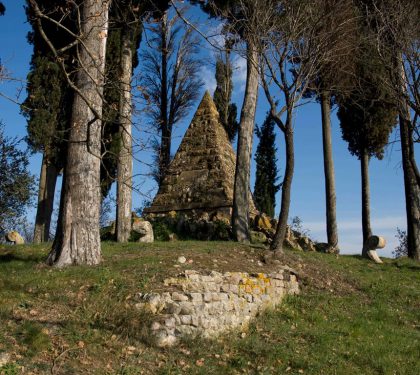
I Nove or the Nine Lords and the Creation of the Most Beautiful Square in the World
During this period, the Siena as we know it today was built. In 1287, the city council led by the consoli and controlled by the aristocratic “magnati”, the wealthiest and mostly noble families, was replaced by a more democratic government, involving more social middle classes. There was no democracy as we know it today, but Siena was probably the closest thing to it in European history with a board elected from merchants and bankers, and even some shopkeepers and artisans. The administration lay with I Nove or De Negen Heren, citizens who were elected to govern the city for 6 months at a time and who were not even allowed to leave the town hall. The Sienese also had a sense of humor because, in addition to the magnati, lawyers and notaries were excluded from election “because they were too dangerous for the proper functioning of the administration”. Shortly before 1300, the Nine bought houses and land around the Campo, a meadow in the center, with the aim of creating a new city center, the Piazza del Campo, bordered by the Palazzo Comunale and the Torre della Mangia on one side and Palazzo Sansedoni obliquely on the opposite side and very similar to the town hall as prescribed by the strict urbanization laws (already then) that required windows with one or two part columns and prohibited terraces.
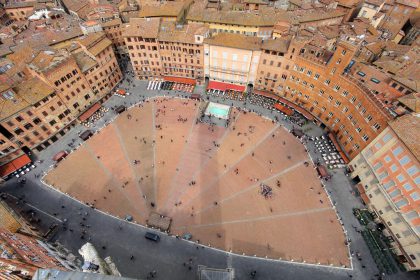
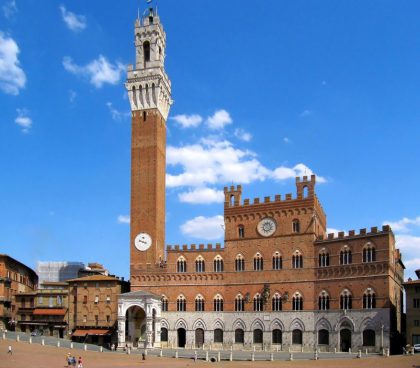
Between 1297 and 1310, the Palazzo Pubblico or Comunale or City Hall was built, with the large loggia at the rear from which the Nine Lords could take a breath of fresh air in the evening and contemplate their city. Between 1325 and 1348, the slender, female Torre del Mangia was built (compared to the male tower of the Palazzo Vecchio in Florence), 102 meters high and second highest in Italy. In 1333-1334 the unique piazza was completed, divided into nine parts, sometimes compared to a fan or the protective cloak of the Madonna, patroness of Siena, but actually symbolic of the Nine Lords who ruled the city. In 1339 the Sansedoni completed their grand palace opposite.
The Duomo: A Megalomaniacal Dream Shattered by the Black Death
And they had even bigger plans. Probably between 1150 and 1317, the Duomo of Siena was built as we know it today, on the roof of an earlier church from the 9th century.
The works were accelerated from the middle of the 13th century. In 1317 it was decided to extend the existing church with a new choir to be built on the roof of a Battistero or baptistery built to the east under and at the foot of the existing church, now reached by a wide, steep but especially beautiful staircase. But when this project was completed, it was determined that the church was too small. Moreover, those cursed Florentine rivals had decided to build Christendom’s largest church, so Siena could not be left behind. In 1339 it was decided that the existing church would become the transept or transept of a new church, by the construction of a new large and wide central nave, and work began immediately.
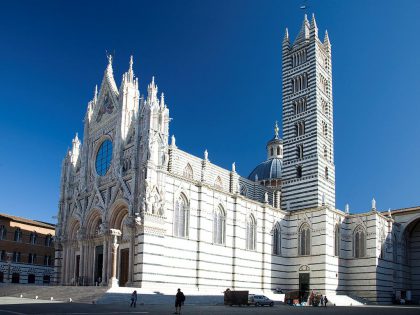
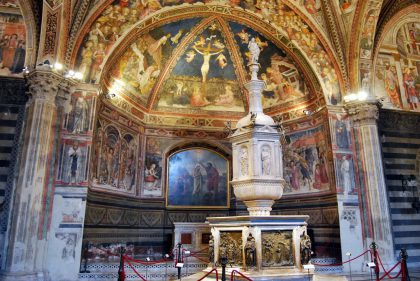
In 1343, another plague epidemic developed in Central Asia, reaching Sicily in October 1347 on board ships via fleas that lived on rats, and in the spring of 1348 Tuscany via the port of Pisa. The Black Death literally spread around the world at a killer pace. It is estimated that between 75,000,000 and 150,000,000 people died in Europe and Asia between 1346 and 1353, ie between 40 and 60% of the population. It was the largest of the many plague epidemics that would ravage Europe until the 17th century. Only then would the world’s population return to pre-plague levels. In the early summer of 1348 the disease reached Siena and it is estimated that in 6 weeks at least 40% of the population died, and it cannot be ruled out that it could have been even 60% as in Florence. It was not the end of Siena, but the formidable dynamism had been sucked out of the city. Work on the new cathedral was permanently halted and never resumed. Today, the impressive skeleton of the new main nave testifies to the heroic plan of the Sienese : high white walls with Gothic windows but no roof.
The Ospedale Santa Maria della Scala
The oldest mention of the Ospedale Santa Maria della Scala dates from 1090, but it was probably older. It was a hospital, a shelter for poor and abandoned children and for pilgrims who traveled to Rome along the Via Francigena. In 1320-1330 the hospital was renovated and enlarged and was one of the oldest and probably the largest of the Middle Ages. The Santa Maria della Scala became increasingly rich through all kinds of donations and in the 14th and 15th centuries was the most important landowner of the republic with farms, shelters and even castles spread over the entire area controlled by Siena.
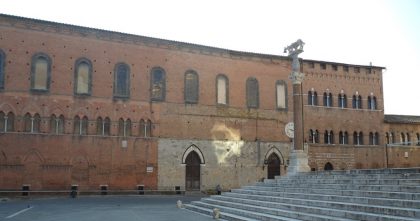
Siena dominates the painting of Europe
Around 1270, the new European painting was born in Florence through Cimabue and his brilliant pupil Giotto. Siena found an answer in the formidable Duccio di Buoninsegna (ca. 1255 – 1319). Duccio, however, remained more like Giotto influenced by the Byzantine masters and opted for supple, dynamic lines and an extremely refined design (Compare his Maestà or Enthroned Madonna in the Uffizi Museum in Florence with Giotto’s, which is more powerful and plastic). In 1311 his great Maestà, a Madonna enthroned among saints and angels, and with dozens of magnificent small panels depicting the Life of Christ, was carried in triumph through the streets of Siena from his studio to the Duomo. Today we can admire them in the Museo dell’Opera del Duomo (Museum of the Art Treasures of the Duomo), which is embedded in the skeleton of the unfinished nave of the church. In the museum itself, one can reach a balustrade on one of the walls of the skeleton via a steep staircase and be rewarded with a breathtaking view of the city and the surrounding landscape.
Giotto turned out to be succeeded in Florence by a few good but not exceptional painters. They did exist in Siena, which dominated European painting for almost 50 years, often with a more plastic style like Duccio and increasingly refined like the Florentines.
Duccio was succeeded first by Simone Martini (1284-1344), whose frescoes we can admire in the Palazzo Comunale, and then by the brothers Pietro (ca. 1280-1348) and Ambrogio Lorenzetti (ca. 1290-1348). Both died of the plague. Ambrogio’s will has been preserved from June 9, 1348 in which he transferred all his goods to a religious brotherhood, because he knew that not only he, but also his wife and three daughters could die at any moment.
Ambrogio is the master of what is the first and possibly the most important political work of art in all of art history. In 1338-1339 he painted the so-called Allegory of the Good Government, the Allegory of the Consequences of the Good Government in the City and the Countryside, on three walls over a total of 35 meters, on behalf of De Negen in their Council Chamber of the Town Hall and the Allegory of the Consequences of Bad Government in the City and Country. The first fresco on the back wall of the room shows the city rulers surrounded by all kinds of Virtues that assist them in their work, a beautiful but rather theoretical work. But on the right, Ambrogio amazes with a wonderful panoramic and lively representation of Siena and the surrounding countryside in which all kinds of activities take place, testifying to peace and prosperity and progress. We get a unique insight into the society of that time with schools, workshops, construction activities, trade, transport, agriculture, hunting and fishing. The landscape outside the city is still the same as today. On the other side robbery, murder, arson and rape. However, this fresco is badly damaged. Large fragments are missing, but you will still find some penetrating scenes here, including the symbolic representation of all kinds of vices. It is certainly a genius piece of propaganda art for the Reign of the Nine.
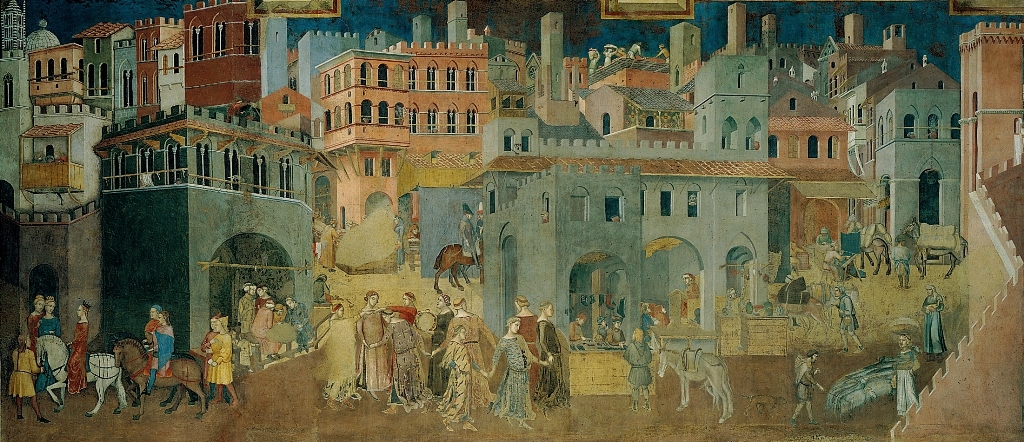
After the Black Death, Siena had numerous refined, sometimes good but rather uninspired masters. The dynamics had also disappeared in the artistic field.
The Fall of the Nine and the Reign of the Twelve
And the enlightened reign of the Nine also came to an end. On the one hand there were accusations of corruption and mismanagement, but the Nine were especially powerless against a wave of disorder, violence, arson and murder in the years after the Black Death. The “magnati” like Tolomei and Salimbeni fought against the city government and fought among themselves. Threatening famine was fought through higher taxes to buy food. There was a slowdown in international trade and banking, and mercenary robber bands swept through the countryside. On March 25, 1355, the entire city government, including the judicial, financial and military officials, was driven out by the mob with the support of magnati, and replaced by I Dodici or The Twelve, i.e. 12 representatives of the people and back 12 nobles, who strangely enough administrative principles of the deposed Nine.
Historians are very lenient towards The Nine and consider their reign as harmonious, calm yet dynamic, original and innovative because of the emphasis they placed on formalizing their decisions into fixed rules, which was far from evident at the time. In short, it was a short period of Buon Governo, whose ideals Ambrogio Lorenzetti had recorded.
PART III – From the LATE MIDDLE AGES over the RENAISSANCE to the 19th CENTURY
City of Saints and Popes
Siena was a city of many saints. The most important was Saint Catherine (1347-1380). In 1309, the French pope Clement V left Rome for Avignon, much to the dismay of the Italians for religious but also financial reasons. Rome attracted hundreds of thousands of pilgrims every year who, by the way, passed through Siena along the Via Francigena.
In 1375 Catherine had received the stigmata or wounds of Christ in Pisa and a year later she went to Avignon and ordered Pope Gregory XI to return to Rome. Whenever she didn’t get her way, she yelled “Voglio” or “I want it” in a shrill voice and it worked. The pope went back whereupon the cardinals promptly elected a new pope and the so-called Western Schism began, a period of popes and antipopes. She was elected patroness of Europe. In the San Domenico Church on the outskirts of the city, enthusiasts can view her relatively well-preserved head.
The second known saint was Bernardino (1380-1444), a penitent preacher who could terrify the masses in squares with his thunderous sermons against the temptations of the flesh.
No less than four Sienese have become pope.
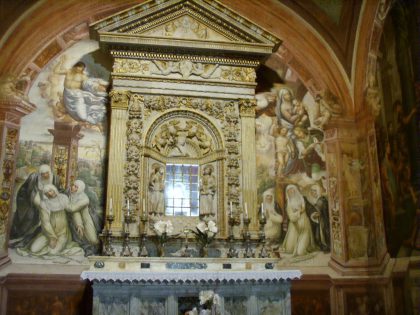
In 1159, Orlando Bandinelli (ca. 1105-1181) became the first Sienese pope as Alexander III. He had to oppose the German Emperor Frederick Barbarossa who wanted more influence in Italy at the expense of the pope. The emerging northern Italian cities united in the Lombard League, did not want imperial interference and supported Alexander. Here the seeds were sown for the great internal Italian conflict between papal Guelfs and imperialist Ghibellines. (Read the History of Siena, more specifically about the Battle of Montaperti and note that Alexander’s hometown was imperialist). In 1177 in Venice the emperor had to kneel before the pope and submit. In gratitude, the Lombards founded a new fortress city which they called Alessandria.
In 1458, Enea Silvio Piccolomini (1405-1464) became the second Sienese pope as Pius II. He was a man of the world who wrote mildly pornographic poems in his youth and who has remained famous for two reasons, one now almost forgotten and one for eternity. In 1456 Constantinople fell and became Istanbul. Pius II wrote a letter to Sultan Mehmet II asking him to renounce Islam and embrace Christianity, prerequisites for becoming Christian Emperor of Constantinople. The sultan did not answer. Pius II was also the last pope to campaign for a crusade to liberate the Holy Land. He died in the port of Ancona where he was trying to form a fleet to go to battle. His biography is immortalized in the Libreria Piccolomini of the Duomo of Siena, a small room decorated with charming, very decorative but by no means masterful frescoes (1502-1507) by Pinturicchio from Umbria.
He is best known for what he did with Corsignano. The pope was a descendant of a distinguished Sienese family, but born on their estate in the village of Corsignano, about 40 kilometers from Siena itself. When he became pope, he commissioned to do something with his native village to the Florentine sculptor-contractor Bernardo Rossellino, confidant of Leon Battista Alberti, the greatest architect of the time, who probably sent plans.
Rosselino built the Duomo in barely four years according to the Pope’s instructions, ie a German Hallekerk, for he had been papal nuncio to Bavaria, but with a Renaissance facade. To the right next to it the impressive Palazzo Piccolomini, to the left a beautiful episcopal palace or Palazzo Vescovile, and opposite the Palazzo Comunale or town hall. The pope also urged other cardinals and bishops to build palaces to give the village allure. The result is a beautiful early Renaissance mini-town of barely 2,000 inhabitants, situated on a hill with breathtaking views of the beautiful Val d’Orcia, and now known as Pienza after Pope Pius. An absolute must for anyone visiting Tuscany.
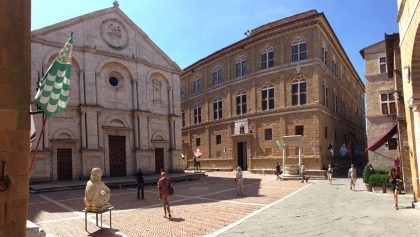
On September 22, 1503, Francesco Piccolomini Todeschini (1439-1503) from Siena became pope as Pius III and died 27 days later on October 18. There is nothing to say about him except that he was the pope between the infamous Alexander VI Borgia and Julius II, the patron of the new Saint Peter and of Michelangelo’s Sistine Chapel and much more.
And finally in 1655 Fabio Chigi (1599-1667) from Siena became pope Alexander VII. He too owes his fame to a work of art rather than to a grand administration of the church. He commissioned Bernini to build the grandiose colonnade for St. Peter’s in Rome.
Pandolfo Patrucci : an experiment with an Overlord
Siena remained an independent republic and city-state against any pressure from Florence, which expanded its territory to include other major Tuscan cities such as Arezzo (1384) and Pisa (1406 and 1509). A remarkable period was the reign of Pandolfo Petrucci (1452-1512), who from 1487 almost ruled the city as sole ruler. He was feared and hated, among other things, because he intertwined his own financial and economic interests with the government of the state and was ruthless towards his many enemies. On the other hand, he was a tower of strength in protecting the republic against foreign enemies in a very turbulent period of Italian history. He was called the “Defensor Libertatis” or “Defender of Liberty” against the meddling of French kings and especially against Cesare Borgia, bastard son of Pope Alexander VI, model for Machiavelli’s “The Prince” and the most dangerous man of his time. Not far from the Duomo is the Palazzo del Magnifico in Siena.
The Renaissance: “Firenze is not 40 but 40,000 miles from Siena”
In the artistic field, something very strange happened. While Siena was a pioneer in the artistic field at the end of the 13th and the beginning of the 14th century with its own variation on the Florentine innovations, the Sienese now continued to opt for a refined, ossified and therefore outdated style. The Florentines had developed the new Renaissance style, with great attention to space and perspective, with plastic figures based on a careful study of human anatomy, and with a great sense of the psychology of the characters. The Sienese did not seem to understand this and painted “as if Florence were not 40 but 40,000 miles from Siena” as the famous art historian Bernard Berenson aptly wrote. An exception was Sassetta (1391-1450) who joined the first Florentine masters such as Masaccio, Uccello and Lippi, but was not followed in Siena.
Strangely enough, they did have a great sculptor, Jacopo della Quercia (ca. 1374-1438) who was one of the founders of the Renaissance style with the Florentines Donatello and Ghiberti. He too found little imitation in Siena, but made a great impression on Michelangelo Buonarotti 75 years later. Witness to this are Fonte Gaia in the Piazza del Campo opposite the Palazzo Comunale.
It is very curious that non-Sienese painters have hardly been represented in Siena, and certainly not the great Florentines whose services were fought for elsewhere in Italy, but that many appeals have been made to Florentine sculptors such as Donatello, Verrocchio and Michelangelo, and more on Nicola Pisano and Bernini.
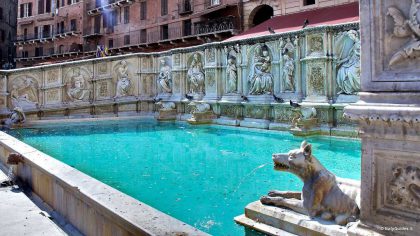
Architecturally, they continued to build in Gothic style until well into the 17th century, which is unique in Italy. The few Renaissance buildings in Siena are mostly Florentine constructions such as the impressive Palazzo Piccolomini, close to the Piazza del Campo, built for the family of Pope Pius II.
And the Sienese had not forgotten banking. Agostino Chigi (1466-1520), member of one of the most powerful and wealthiest Sienese families, arrived in Rome in 1487 as his father’s servant, first became banker to the notorious Borgia Pope Alexander VI and other monarchs, became banker to the pope in 1503 Julius II, who sponsored his conquest of central Italy, the Papal States, became the financial backer of the construction of St. Peter’s, of the frescoes of the Sistine Chapel by Michelangelo and of so many other works of art of the High Renaissance. He was active as a papal diplomat, and also became an entrepreneur with activities all over Europe, at one point employing 20,000 people, and as the richest man in Christendom, was honored by the Republic of Siena with the honorary title “Il Magnifico”, strangely enough a title which was also sometimes used to designate Pandolfo Petrucci.
1555 The Fall of the Republic of Siena
Lorenzo il Magnifico dei Medici, the uncrowned ruler of Florence in the 15th century, had failed to conquer Siena. His descendants succeeded. In 1537, the Medici became hereditary dukes of Florence with the support of the powerful Emperor Charles V. And on April 21, 1555, the Republic of Siena was conquered by the Medici and troops of Emperor Charles after a one-year siege, exhausted by famine. A group of Sienese did not surrender, fled 25 kilometers further to the small town of Montalcino and founded the Repubblica di Siena riparata in Montalcino, roughly translated “the Republic of Siena restored to Montalcino”.
The conquest of the republic except for that one brave town was confirmed by the Peace of Cateau-Cambrésis in 1559, which ended the Italian Wars and the conflicts between Habsburgs and France, and Montalcino surrendered. On August 27, 1569, Pope Pius V officially named the Medici Grand Dukes of Tuscany.
In a way, the Palio is also a celebration and commemoration of what Siena once was: a small city-state but a powerful republic, a European financial, economic and artistic great. It is all symbolically encapsulated in the Corteo Storico or historic procession that, for more than two hours, moves defiantly slowly through the Piazza in the run-up to the race.
A strange detail is that all the villages and castles of the republic participate in the procession via flags, but that only Montalcino has a larger delegation, as representatives of the last city that surrendered to the Medici in 1559. For which annual respect in the procession.
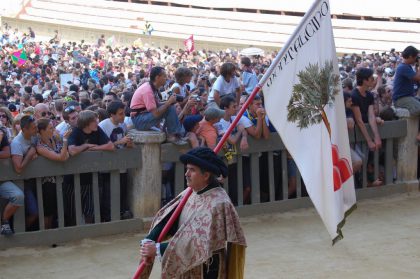
A provincial, hushed Nest : “creaking, flaking, disappearing, crumbling, rotting”
And Siena became what it is today : a provincial nest of extraordinary beauty. Foreign cultured travelers such as the English Lords on their Grand Tour in the 18th century were struck by the time that seemed to have stood still in Siena and left the city with mixed feelings and little understanding of its Gothic character, which was no longer in vogue and had yet to be rediscovered, as happened especially from the 19th century.
The great American novelist Henry James visited Siena in 1873 and mercilessly described the city: “Everything is cracking, peeling, fading, crumbling, rotting” or “Everything is cracking, flaking, disappearing, crumbling, rotting”. “No young Sienese can rest their eyes on something youthful : they open on a world (battered) exhausted or battered, and (befouled) rotten or unusable by long use. But he added: “the city softens and does not irritate”. He was surprised by the nightlife of the elite who invited him to concerts and intellectual conversations at 2 am. James was fascinated with Siena and returned often. In 1909 he wrote that he had actually made a mistake with his first too negative judgment (poor judgment). In “Italian Hours“, his Italian travel memories, he therefore divides Siena into two chapters “Siena Early and Late“.
PART IV – THE TWENTIETH CENTURY
The French General De Monsabert, a man of culture, had to liberate Siena and ordered General Beçancon, his artillery commander, who asked for orders, to shoot only at what was built after the 18th century. “But then I cannot shoot, mon général”, and so it happened. Siena was liberated on July 3, 1944 with minimal damage. (Read also the story: The last Battle of the War – The Palio of Peace)
It was not until the 20th century that Siena sought to join the new world. The Policlinico Le Scotte, the gigantic new hospital outside the city, became a pioneer in the medical field, partly under the impetus of the university. Famous Russian dissident Sakharov chose Siena for a complicated operation on his eyes.
The Istituto Achille Sclavo became an international name in the pharmaceutical field, employs 3,000 people, is now American-owned and also partners with Swiss giant Novartis.
Being the center of a large agricultural area, Siena also became famous for its delicacies. Several companies (Sapori, Pepi, Nannini, Parenti) are known for their delicious panforte. Add to that the wines from the southern Chianti, the topper Brunello from Montalcino and the Vino Nobile from Montepulciano, the vinsanto and, for several decades, the local grappa. The wine industry in the region has been extremely dynamic since the renewals started at the end of the 1970s and is still in full development with new vineyards in places previously considered unsuitable for viticulture, such as the area around Bolgheri and the Maremma.
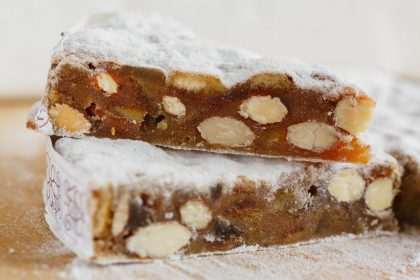
And another important economic activity has been added: the agriturismo or holiday in Tuscan farmhouses. Farmers lived and worked until 1945 in the so-called mezzadria system from the Middle Ages. The land belonged to mostly noble landowners. The farmers were obliged to share the produce with them and were actually not allowed to leave the farms, a semi-serfdom. Mussolini’s fascists did not intervene either and lost the confidence of the peasantry. During and after the liberation, the communists were the strongest advocates of distributing those lands among the poor peasants. This explains why Tuscany, alongside Umbria, Le Marche and Emilia-Romagna, the agricultural areas of central Italy are still “red” strongholds despite their great wealth. In addition, many farmers moved to the factories in Milan and Turin during Italy’s economic boom from the 1950s. Many farms were suddenly empty. And from the late 1970s, many farmers understood that they were actually on gold mines. Farms were restored and converted into beautiful holiday homes or bought up by foreign millionaires and Belgian politicians.
Finally, I would like to draw attention to the not entirely unjustified description of Siena as the safest city in the world, which is no mean feat in a country like Italy with its known problems. This safety was always explained by the social control exercised by the contrade on their inhabitants and members with their age-old tradition of mutual assistance and organization of neighborhood activities. In addition, anthropologists pointed to the strange effect of the Palio, days often marked by riots between contrade. Zoologist Desmond Morris once wrote: “Twice a year, they cream off the violence in Siena”. Twice a year, in an explosion of Palio excitement, all accumulated unease of any kind is channeled and creamed off, after which the city is fairly quiet for the rest of the year. And indeed, it is difficult to understand that Sienese can continue to live together after the emotions of the Palio, and yet it is. The Palio separates and connects. However, the depopulation of the historic center may lead to a reduction in the intensity of relations. Some already speak disparagingly about the “quattrogiornisti”, contradaioli that are never seen during the year but only appear during the four hectic Palio days.
It should also be noted that in 1989 Prince Charles made a remarkably controversial documentary for the BBC, “A Vision of Britain”, a full-frontal attack on contemporary architecture in Britain, citing Siena as an example of how things can and should be done. .
PART OF – THE TWENTY-FIRST CENTURY
The Fall of Monte dei Paschi di Siena or The End of the Myth of Il Buon Governo
La Muccona
And then we must also talk about the rise and fall of the city’s pride: the Banca Monte dei Paschi die Siena. The Sienese proudly announced throughout the world that this was the oldest surviving bank in the world, founded in 1472. 500 years later, a Palio straordinario was even decorated to celebrate the anniversary. The bank was the cash cow of city and province who was its sole shareholder and is derisively called La Muccina or the Big Cow. Rich dividends allowed the city to afford works that made the whole of Italy jealous: underground car parks in the old town, long underground escalators carved into the rock that take visitors from the outskirts of the city to the center, the Teatro dei Rozzi and the Teatro dei Rinnovati, two theaters from the 18th century and renovated for a fortune in 1817, a better road surface than elsewhere, small but very well-kept museums in restored palaces in villages (The Museo di Palazzo Corboli in Asciano, and the Antiquario di Poggio Civitate-Museo Archeologico in Murlo), a Center for Contemporary Art in the 15th century Palazzo delle Papesse (closed after 2008) and also the project for the Ospedale Santa Maria della Scala. In 1995 the last rooms for patients were vacated. The city developed a megalomaniac plan to use the large spaces as a museum complex, even discussing a new Beaubourg. Montepaschi invested 50,000,000 euros. Initially, a museum for ancient art was set up, the highlight being the Sala del Pellegrinaio with 15th century frescoes. It also housed an Etruscan museum. And gradually it also had to become an international exhibition center.
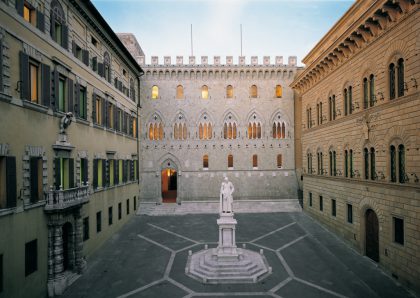
And Siena also amazed the sporting world with achievements beyond the capacity of a small provincial town. Already in the 1980s, Siena showed that it was capable of a lot in the sporting field: a top athletics track, meetings of international allure, and unprecedented at that time: Siena Atletica counted foreign professional athletes among its members: the Moroccan Said Aouita, world record holder 1500, 3000 and 5000 meters, Olympic Champion 5000 meters in 1984 and bronze in 800 meters in 1988. He was a unique athlete in that he dominated from 800 to 5,000 meters. He was joined by Roland Desruelles from Antwerp, European Champion 100 meters indoor.
In 2003 Siena Robur was promoted in the Serie A of the Italian football league, in a small stadium and in front of a small number of spectators, at the level of a very modest Belgian first division. Robur Siena lasted until 2010, was relegated and came back for two more seasons in 2011 under Antonio Conte, later manager of Juventus and Italia, from Chelsea in the summer of 2016 and now Inter and Lukaku.
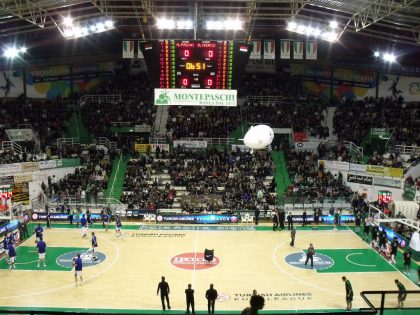
Even more impressive was the performance of Mens Sana Basket Siena. In 2000, the Montepaschi took over the sponsorship and they have known that in Italy. In 2001-2002 they won the Saporta-Cup, the second European cup. In 2003-2004 they became Italian champions and between 2006 and 2013 they won seven consecutive titles, never seen in Italy, and in the meantime they took five more Italian Cups and reached the Final Four three times, say the final round of the Champions League Basket and each time just missed the main prize. Between 2006 and 2013, Montepaschi sponsored Mens Sana for 100 million euros, an average of 14 million euros per year, more than what all Belgian first-class football teams receive together. By the way, little Robur also received up to 13.5 million euros a year from Montepaschi.
The sky was the limit. And it also helps explain why Italy’s richest city continued to vote left-wing at first and after the fall of the Wall. A new variant of the Buon Governo through shared wealth. And then disaster struck.
The Banca Monte dei Paschi di Siena was a rather local bank as is not unusual in Italy, expanded in 1929 with the acquisition of the Banca Toscana, became a public credit institution in 1936, showed initiative in 1990 when it became the first Italian bank insurance began to offer. The Amato-Draghi law of 1992 allowed the privatization of public credit institutions (as happened in Belgium with Gemeentekrediet and A.S.L.K.) and laid the foundation for the next steps. In 1995, the Italian State decided to divide the bank into 2 institutions : a bank and a Fondazione or foundation, a non-profit organization that managed the shares and used the dividends for investments in art, scientific research, health and education. In 1999, the bank went public, so other shareholders came along who contributed capital that enabled the bank to expand in Italy and Europe, including in Belgium, and develop new activities. The city and province did ensure that they retained 51% of the shares and therefore complete control of the bank.
The Doom
On November 8, 2007, Montepaschi proudly announced that it had bought Banca Antonveneta from Padova for 9 billion euros from Banca Santander. Insiders thought the amount was quite high, especially because the bank had an injection of no less than 8 billion from Santander that had to be repaid, and which therefore increased the cost to 17 billion. Afterwards, it was also found out that the purchase had been made without a “due diligence” or careful examination of the books as is customary and actually necessary when taking over a company. Santander had banned this research and made it a condition of sale. And Montepaschi had accepted this in a fit of madness or should we say total ignorance of Giuseppe Mussari, the bank’s CEO. Mussari was born in Catanzaro, studied law at the University of Siena, became a lawyer there in 1993, and as a beautiful, “il bel Giuseppe” and intelligent man, had gained quick access to “the salons of Siena that counted in decision-making ”, in short, had made a career within the leftist Partito Democratico that controlled Siena since 1945. In 2001 he had become president of the Fondazione and in 2006 CEO of the bank, without any banking knowledge or experience. Quatongues claimed that the operation was ordered by Massimo D’Alema to the “red” brothers in Siena and especially to his confidant Mussari. D’Alema was a heavyweight in the Partito Democratico, formed from a merger of ex-communists and left-wing Christian Democrats. When he was prime minister in 1998-1999, he dreamed of a merger of Montepaschi and BNL, another top Italian bank, to have a major gateway to the national economy, and of course controlled by the PD.
Montepaschi had a big problem but the worst was yet to come. People relatively easily survived the first banking crisis of 2008, but with the second crisis of 2011, the house of cards began to collapse. A loss of 4.7 billion euros was recorded by Antonveneta, and by a large loss on the portfolio of Italian government bonds, which was then heavily speculated and which led to the political fall of Berlusconi. And of course this bank also worked with the new dangerous banking products that no one understood, certainly not Mussari, and which had been introduced by a “banking specialist”, who happened to be a confidant of D’Alema.
The responsibility of the left is very great in Siena, but all other parties have butter on their heads. The left-wing majority has always involved the opposition in all major projects and appointments of bank and city institutions. And so everyone was satisfied and no one protested
I will spare the reader what happened afterwards in and around the bank, the scandals and the bailouts, but I will give the consequences for the city.
The Consequences for the City
The city and province of Siena still hold 2.5% of the Fondazione’s shares, which have become virtually worthless, with the result that the annual waterfall of subsidies has come to an end.
Robur has gone bankrupt, restarted and plays in third division.
Mens Sana went bankrupt fraudulently in 2014, restarted , plays in third division and faces another bankruptcy .
The activities of the Santa Maria della Scala, the Italian Beaubourg, are at a low ebb and despite the 50 million euros from Montepaschi, the renovation is only half complete.
Mussari had to resign in 2012, stating: “This is not my job and I don’t want to mix it with my profession. I will be a lawyer again, the only profession I know”, a rare moment of self-knowledge from a provincial lawyer who went on to manage a top European bank. In November 2014, Mussari was sentenced to 3.5 years in prison for the Alexandria affair, an attempt to cover up Antonveneta’s hole through a fraudulent scheme with Japanese bank Nomura.
A rector of the Ateneo dreamed of making the university “una piccola Oxford”, but in 2008 she turned out to have no less than 200 million euros in debt. The Tuscany region has bought Le Scotte for 110 million, which has relieved the pressure somewhat. Incidentally, the university is regarded by the contrade as their historical enemy, because it owns too much real estate as premises, and because the students live in too many apartments, which drives up the price of the real estate and many contradaioli can no longer afford to live in the contrada itself, and have to move to the periphery.
In 2015, SIENA BIOTECH went bankrupt even though it had received no less than 160 million euros from 2000 to 2014 from the Fondazione, which had invested in technological research in accordance with the statutes.
Politics was also rumbling in the city. Mayor Ceccuzzi had to resign in 2012 after a scandal involving Montepaschi, was succeeded by a commissioner sent by Rome to break the impasse, and succeeded in 2013 by a new mayor who is now also under heavy pressure due to several scandals. And then, in the municipal elections of 2018, for the first time since 1945, a right-wing municipal council and a right-wing mayor were elected: the final implosion of rich and yet “red” Siena. The new mayor promptly organized a Palio Straordinario in October 2018, the first since 2000, supposedly to commemorate the end of the First World War, but in fact to celebrate the change of political power. And he was lucky: it was summer on October 20, 2018. A few days later, an unprecedented autumn rain washed through the city.
I conclude:
Siena is still a rich and prosperous city.
Every year, Il Sole 24 Ore, Italy’s leading financial and economic newspaper, publishes a chart of all Italian provinces in terms of quality of life. And the winner… was several times Siena despite the expensive price of the real estate. In terms of income, medical and social services, security and attractiveness of life, Siena was unbeatable. In 2014 Siena was still a nice ninth place, down from a fifth in 2013, high at the top, but the first place seems far away due to the shock waves of the financial crises of 2008 and 2011 that have left deep wounds in the cash registers of the local bank, the city and the citizens, but also had a negative impact on employment, morale and self-confidence of the Sienese themselves. Nevertheless, through the bank and Fondazione, they have succeeded in building an infrastructure that is far superior to the rest of the country. The question is how this can be maintained in the future.
And Siena remains the most beautiful medieval Gothic city in the world .
But the myth of the Buon Governo or Good Government of the Nine Lords, which is said to have been reborn in the twentieth century, is definitively shattered. However, we can continue to admire the ideal in the probably utopian frescoes of Ambrogio Lorenzetti.
